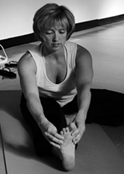A slow journey to relaxation
K-State professor teaches Noontime Yoga for fitness, repose
Calming music filters out of the makeshift studio, drowning out the sounds of tennis shoes squeaking on the basketball court below.
 In the humid little room in Ahearn Gymnasium, about a dozen students bend and stretch, practicing yoga under the direction of Sue Brown, K-State professor of biology.
In the humid little room in Ahearn Gymnasium, about a dozen students bend and stretch, practicing yoga under the direction of Sue Brown, K-State professor of biology.
Brown, who has been an instructor for the Noontime Yoga program for several years, says it's a great way to stay fit and de-stress.
"Some days are stressful, and yoga gives me a chance to relax and reprogram," Brown said. "With yoga you learn about your muscles and breathing techniques. And when practicing, it really helps you focus on the here and now, and not on all of the other things that may cause stress."
Brown was introduced to yoga while a graduate student in the 1980s, but at the time, it didn't interest her.
"It seemed complicated and hard to do," she said.
Fast-forward 25 years, and Brown was ready to give yoga another shot. She began attending Noontime Yoga sessions in 2002 and eventually worked up the confidence to try instructing others.
"C.P. Ward really inspired me to become an instructor," she said. Ward is a Manhattan resident who still teaches Noontime Yoga.
Brown also credits Diane Knox, K-State assistant in kinesiology; Emily Ragan, K-State graduate student in biochemistry; and Manhattan resident Carol Gould with inspiring her to teach yoga.
"Emily and I took instructor classes together to become certified to teach, and the other three women were volunteering their time instructing, and I loved the way they taught," Brown said. "In yoga you try to emulate your yoga master, and that's what I try to do when I teach."
With the semester winding to a close and stress mounting, Brown said Noontime Yoga instructors have begun working with poses that are good for relaxation.
Anyone can attend any of the five weekday sessions, and you don't have to be in great shape to participate, Brown said.
"You just have to be able to stand up or sit down," Brown said. "Many of the people who attend were advised by their doctors to try yoga, and we mix all levels.
"We don't do power yoga. What we do is meant to warm and stretch the muscles and build a balance of strength and flexibility."
It may seem like Brown is increasing her own stress levels by adding yoga instruction to her teaching, publishing and researching, but she says it's all about having a plan.
"You have to stay organized," she said. "But I feel better when I do yoga, and it allows me a break in the middle of the day."
Not only does yoga teach you to listen to your own body, but it also can help you become more attuned to others, she said.
"I get the chance to meet new people and have new experiences through instructing."
Noontime Yoga began in 2002. In addition to Ragan, Brown and Ward, Dave Mitchell, laboratory education technician for the College of Architecture Planning and Design, also teaches the sessions.
Photo: Sue Brown, professor of biology, teaches two sessions of Noontime Yoga and says it’s a great way to relieve stress and maintain fitness. Noontime Yoga classes meet from noon to 1 p.m. each weekday in Room 302, Ahearn Gymnasium.